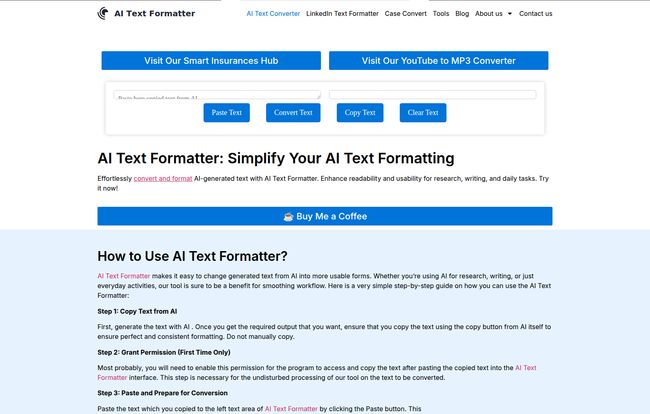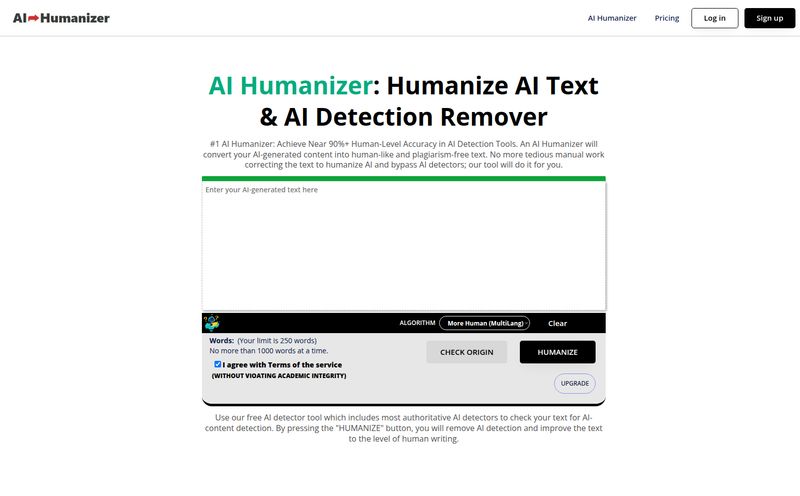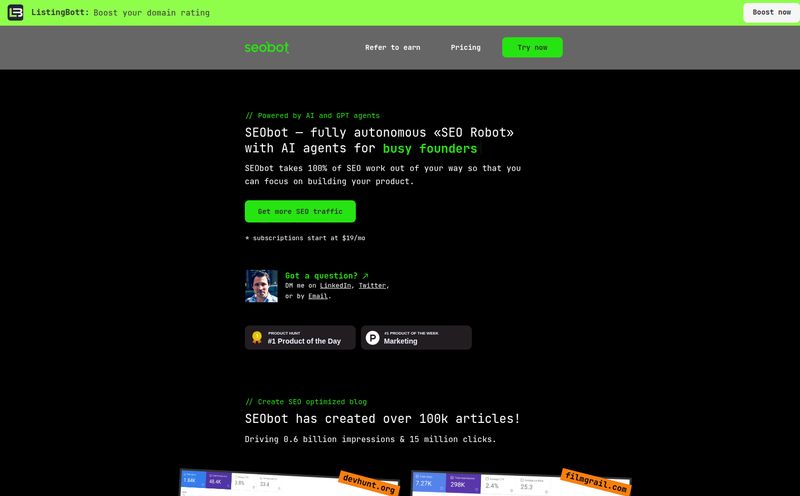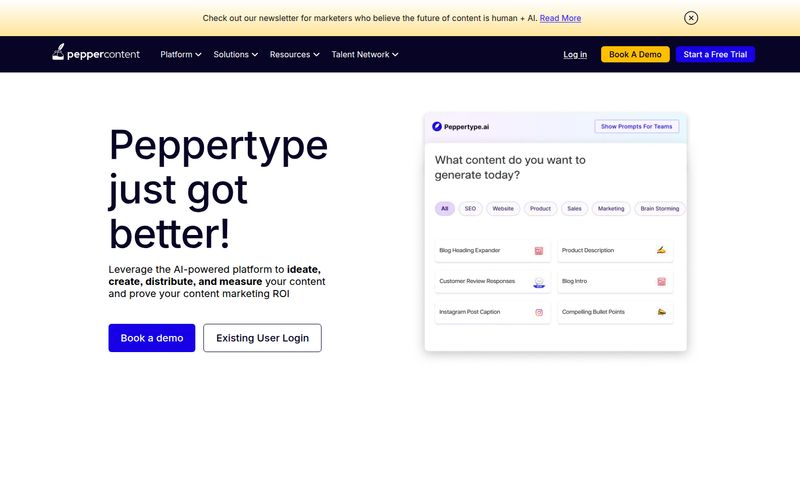We're all using AI in our workflows. Whether it's for brainstorming blog post ideas, drafting emails, or just getting a little help with a tricky bit of code, tools like ChatGPT, Claude, and Gemini have become indispensable. But we've also all been there: you ask for a detailed explanation, and what you get back is a single, monstrous block of text. A wall. A veritable fortress of words with no paragraphs, no breaks, no soul.
It's a pain to manually format this stuff. Especially when you're on a deadline. You end up spending more time hitting 'Enter' and adding bullet points than you saved by using the AI in the first place. It’s one of those little frustrations that builds up over the day. So, when I stumbled upon a super simple, single-purpose tool called AI Text Formatter, my curiosity was definitely piqued. Could this be the digital spackle for the cracks in my AI-assisted process? I had to find out.
So What Is This AI Text Formatter Thing?
Think of it as a digital iron for your wrinkled, just-out-of-the-dryer AI text. The AI Text Formatter is a straightforward, no-frills web tool designed to do one thing and one thing well: take that clunky, often poorly formatted output from an AI and instantly convert it into something clean, presentable and readable. It’s not trying to rewrite your content to 'evade detection' or add fancy jargon. It's a pure utility player. Its goal is to improve the usability of the text you already have, making it perfect for pasting into documents, research papers, emails, or even your CMS.
I’ve always felt the best tools are the ones that don’t try to be a Swiss Army knife. They’re more like a perfectly weighted chef's knife—they do one job, but they do it flawlessly. That seems to be the philosophy here.
A Quick Walkthrough: How It Actually Works
The beauty of this tool is its sheer simplicity. There isn't a steep learning curve. In fact, there's no curve at all. It's a straight line. Here’s my experience using it, step-by-step:
- Step 1: Paste Your Text. You generate some content from your AI of choice. You copy it. You navigate to the AI Text Formatter website and you paste it into the box on the left. Easy enough.
- Step 2: Grant Permission (Just Once). The first time you do this, your browser might ask for permission for the tool to access and copy the text. This is a standard browser security feature. According to their site, this is a one-time thing needed for the tool to actually read what you've pasted. I'll touch on this again later.
- Step 3: Click the Big Blue Button. You can't miss it. It says “Convert Text.” You click it.
- Step 4: Magic Happens. Okay, not magic, but the tool processes what you've pasted. I imagine a tiny, digital line cook furiously chopping up that wall of text into neat, organized portions.
- Step 5: Copy the Result. The newly formatted, much prettier text appears in the box on the right. You just click the “Copy Text” button, and it's ready to be deployed wherever you need it.
That's it. The whole process takes, and I’m not exaggerating, about five seconds. It's faster than making a cup of instant coffee.
Why You Should Care About Formatting AI Text
Some might argue, "Who cares what it looks like as long as the information is there?" As someone who's spent years staring at analytics and heatmaps, I can tell you: everyone cares. Readability isn’t just a nicety; it’s a critical component of user experience and, by extension, good SEO.
Improving On-Page Engagement and Flow
Walls of text are intimidating. They increase cognitive load and make users bounce. When I get an article draft from a junior writer that's just one long paragraph, I send it back immediately. Why should we accept a lower standard from our AI assistants? Properly formatted text with clear paragraphs, lists, and headings invites the reader in. It makes information easier to scan and digest. This means lower bounce rates and higher time-on-page, both of which are positive signals to search engines like Google.
Making Your Content Instantly Usable
Last week, I needed a quick summary of a technical report for a client email. I fed the report into an AI and asked for five key takeaways. The information was brilliant, but it came out as one breathless sentence. Instead of manually reformatting it, I dropped it into the AI Text Formatter. Two clicks later, I had a perfectly structured, bulleted list ready to paste into my email. It looked professional and saved me that tedious, annoying editing time. That’s the core benefit here: it bridges the gap between raw AI output and a finished, usable product.
My Honest Take: The Good and The...Quirks
No tool is perfect, right? After playing around with the AI Text Formatter for a while, here’s my balanced take.
What I Liked (The Advantages)
The main advantage is its unapologetic simplicity. It’s incredibly fast and intuitive. There are no settings to configure, no accounts to create, no premium features held hostage behind a paywall. It solves a specific, common problem with zero friction. It enhances the readability of AI-generated text and makes it immediately more useful. For content creators, students, researchers, and office workers, this is a fantastic little utility to have bookmarked.
A Few Caveats to Consider
First, the permission grant. Giving a website access to your clipboard can feel a bit iffy. While it seems necessary for the tool's function, privacy-conscious users might pause here. My take? I wouldn't paste sensitive information like passwords or private financial data into any online tool, and this one is no exception. For general content, it feels like a reasonable trade-off for the convenience.
Second, its effectiveness is tied to the input. If you feed it a truly chaotic jumble of text, it does its best but can’t perform miracles. It's a formatter, not a content strategist. Also, while exploring the site, I noticed some of the blog links were broken or led to odd places. This gives me the impression it might be a newer project or one run by a small team. That's not a criticism, just an observation—it has that indie developer vibe, which I personally find quite charming.
And What About the Price Tag?
This is often the million-dollar question. The good news? The AI Text Formatter appears to be completely free to use. I couldn't find a pricing page or any mention of a subscription. What I did find was a friendly little “Buy Me a Coffee” button. This is a popular way for independent creators to support their work through small, voluntary donations from users who find their tools helpful. I love this model. It keeps the tool accessible to everyone while giving people a way to show their appreciation. So, if you find it saves you time, maybe toss the creator a few bucks for a virtual latte.
So, Who Is This For?
Who stands to benefit the most from this tool? I'd say the list is pretty long.
- Bloggers and Content Creators: Quickly cleaning up drafts and research notes.
- Students: Formatting research summaries or essay outlines from AI helpers.
- Social Media Managers: Turning AI-generated post ideas into cleanly formatted captions.
- Office Professionals: Drafting reports, presentations and emails without the formatting fuss.
- Researchers: Tidying up long passages of text from academic AIs for easier review.
Basically, if you use AI to generate text for any reason, this tool can probably slot into your workflow.
Frequently Asked Questions
1. What exactly does AI Text Formatter do?
It's a free online tool that takes AI-generated text, which is often poorly formatted, and automatically converts it into a clean, readable format with proper paragraph breaks and structure. It's designed to improve usability and presentation.
2. Is the AI Text Formatter free?
Yes, from what I can tell, it's completely free to use. There are no subscriptions or hidden fees. The website includes a "Buy Me a Coffee" link for users who wish to make a voluntary donation to support the tool.
3. Is it safe to grant permission for the tool to access my text?
This is a standard browser security prompt for tools that interact with pasted content. While it seems safe for general text, it's a good practice to avoid pasting highly sensitive or private information (like passwords or personal data) into any online text tool.
4. Will this tool make my AI content sound more human?
Not directly. The tool focuses on structural formatting—like adding paragraphs and line breaks—rather than changing the words themselves. Better formatting makes the text feel more natural and less robotic to read, but it won't rewrite sentences or alter the writing style.
5. What kind of formatting does it typically apply?
It primarily works to break up large walls of text into logical paragraphs. It identifies where breaks should occur to make the content scannable and easier on the eyes, turning a monolithic block into a structured piece of writing.
Final Thoughts: A Handy Tool for the Modern Toolbox
In the grand scheme of things, the AI Text Formatter isn't a revolutionary, industry-shaking platform. And that's okay. It’s not trying to be. What it is, is a highly effective, wonderfully simple utility that solves a small but incredibly common annoyance for anyone working with AI content.
It’s a perfect example of a tool that knows its job and does it without getting in your way. It will save you time, reduce frustration, and make your work look more professional. For the grand price of 'free', it has definitely earned a permanent spot in my browser's bookmarks. Give it a try; I think you'll be pleasantly surprised.




